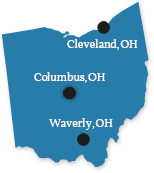You see the news stories every summer: A Lima man killed in a crash after overturning his motorcycle in the middle of the workday. A rider in Youngstown thrown from his bike after losing control, and another experiencing the same fate nearby after driving off the road and hitting a ditch. And yet another motorcyclist is killed when he collides with a car pulling out of a parking lot in Boardman.
These Ohio motorcycle accidents all happened during the summer of 2017 in the same month. Ohio’s roads can be deadly, particularly in the summer when motorcyclists are most likely to be on the road. In fact, motorcyclist deaths in the U.S. occur 27 times more frequently than fatalities in other vehicles.
So, what can we do to prevent these accidents from happening? And if you’re in an Ohio motorcycle accident, how do you get help?
Here is everything you need to know about motorcycle accidents in Ohio, including updated statistics, ways to avoid a crash, how helmet laws work, and when to speak with an experienced motorcycle accident attorney.
Article at a Glance
- There were nearly 4,000 Ohio motorcycle accidents during 2017, resulting in 157 deaths and 3,100 non-fatal injuries.
- All drivers should understand what steps they can take to help avoid motorcycle accidents in Ohio.
- If you’ve been injured in a motorcycle accident in the Buckeye State, contact a Columbus motorcycle accident lawyer today for a free consultation.
How common are Ohio motorcycle accidents?
The State Highway Patrol keeps detailed records of Ohio motorcycle accidents. During 2017, more than 303,000 crashes occurred on Ohio roads, resulting in 109,000 injuries and nearly 1,200 fatalities. Of the total crashes, almost 4,000 involved a motorcycle.
Here are other 2017 statistics about the dangers facing motorcyclists traveling in Ohio:
- 157 fatalities were recorded in motorcycle crashes (139 were drivers of a motorcycle, while the rest were motorcycle passengers);
- Another 3,100 drivers and passengers were injured;
- 35 children under the age of 16 were injured in motorcycle crashes in Ohio;
- The deadliest age group for motorcyclists is 21-25, with 304 people in this category involved in an accident in 2017;
- The next-most deadly group is 31-35, with 298 injured in motorcycle crashes;
- The biggest group of alcohol-impaired motorcyclists injured or killed during 2017 is those age 46-50;
- 14 seniors (age 66+) were involved in a motorcycle crash;
- 53% of motorcyclists who were injured or killed in an Ohio motorcycle accident were not wearing a helmet.
Additionally, most of the people in error during a motorcycle crash were the operators themselves, at 56%. However, 36% of motorcyclist-involved crashes were caused by another driver. (Another 4% were caused by an animal, about 4% with no known/stated cause, and a very small percentage, 0.2%, were caused by pedestrians.)
The total fatalities, injuries, and property damage caused by non-motorcycle drivers in accidents with motorcyclists was 1,381 incidents just last year. That’s a lot of reasons for being more mindful on the road and following some important precautions when riding near or as a motorcyclist.
How to Prevent a Motorcycle Crash
Getting into an accident with a motorcyclist is scary. As a rider, it’s even more terrifying. The Motorcycle Ohio Rider Enhancement (MORE) Program offers a rider’s guide along with educational courses to help Ohio motorcyclists become more skilled so they can avoid danger on the road.
Ohio follows the National Highway Traffic and Safety Administration’s (NHTSA) model national standards for entry-level motorcycle training, which includes motorcycle pre-ride tasks, vehicle control skills, street strategies, roadway management skills, tasks related to carrying cargo or passengers, and factors that adversely affect rider performance.
The MORE Program also offers tips on how to choose your first motorcycle, riding with passengers, and why alcohol and bikes don’t mix. But as many accidents occur with other vehicles, Ohio drivers need to be well-versed in motorcycle safety, too.
Here are some key tips on how to avoid a crash with a motorcyclist, per the NHTSA:
- Share the road. Motorcyclists have different challenges than other drivers on the road. Their size and visibility is a concern, as is how they ride. They need to downshift and weave at times, so when you see a motorcyclist, expect this to happen and follow at a safe distance. Above all, take the time to look out for motorcyclists. Most accidents with motorcycles happen when vehicle drivers don’t see them.
- Don’t take risks. Motorcyclists and vehicle drivers alike should not drink and drive and they should always ride defensively. Follow local traffic laws and signs and proceed cautiously at intersections, looking out for motorcycles, vehicles, and pedestrians. Don’t speed and don’t run red lights.
For motorcyclists, some ways to reduce injury, in addition to getting educated on best roadway practices, include wearing the right gear. The MORE Program insists its riders wear a U.S. Department of Transportation-approved helmet (it’s the law in some cases); eye protection (helmet face shield or goggles); sturdy, over-the-ankle footwear; full-finger gloves; long pants without holes that reach past the top of your footwear while seated; and a long-sleeved jacket or shirt with sleeves that reach the tops of your gloves when your arms are outstretched.
See also: Proving Fault in an Ohio Personal Injury Case
What are the motorcycle helmet laws in Ohio?
Along with nearly half of the states in the U.S., Ohio does not require its riders to wear helmets with few exceptions. You must wear a helmet in Ohio if:
- You are under the age of 18 as a driver or passenger on a bike;
- You are a novice driver with a temporary valid instruction permit; or
- You are a passenger on a motorcycle driven by a novice driver. (Ohio Revised Code 4511.53).
However, all riders do need to have protective eyewear unless they are wearing a mask with a windscreen.
In the U.S., motorcycle helmet use went up from 60% in 2014 to 64% in 2015, according to the NHTSA. Unfortunately, as the Ohio State Highway Patrol’s records demonstrate, only about 40% of riders in motorcycle crashes in Ohio last year were wearing helmets—and this despite the fact that those helmets save lives: Among motorcyclists involved in accidents during 2017, only 2.5% of those wearing helmets were killed, compared with almost 5% of those not wearing helmets.
Still undecided about wearing a helmet? The NHTSA provides this estimate on their effectiveness:
Helmets are estimated to be 37% effective in preventing fatal injuries to motorcycle riders and 41% for motorcycle passengers. In other words, for every 100 motorcycle riders killed in crashes while not wearing helmets, 37 of them could have been saved had all 100 worn helmets.
More information about motorcycle safety, including training sites and rider courses, can be found at the Ohio Department of Public Safety’s Motorcycle Ohio website. More on Ohio motorcycle laws and rules can be found here.
Contact a Columbus Motorcycle Accident Lawyer for Help
Ohio motorcycle accidents can lead to serious injuries, from broken bones and muscle damage to traumatic brain injuries and amputations or death. If you or a loved one has been in a motorcycle accident, the experienced personal injury attorneys of Plevin & Gallucci are here to help.
For more frequently asked questions about Ohio motorcycle accidents, including the process for getting compensation, whether it matters if you were the operator or a passenger, and what to do if you weren’t wearing a helmet, check out our Ohio Motorcycle Accident Attorneys page. Contact us today for a free, no-obligation case review.

